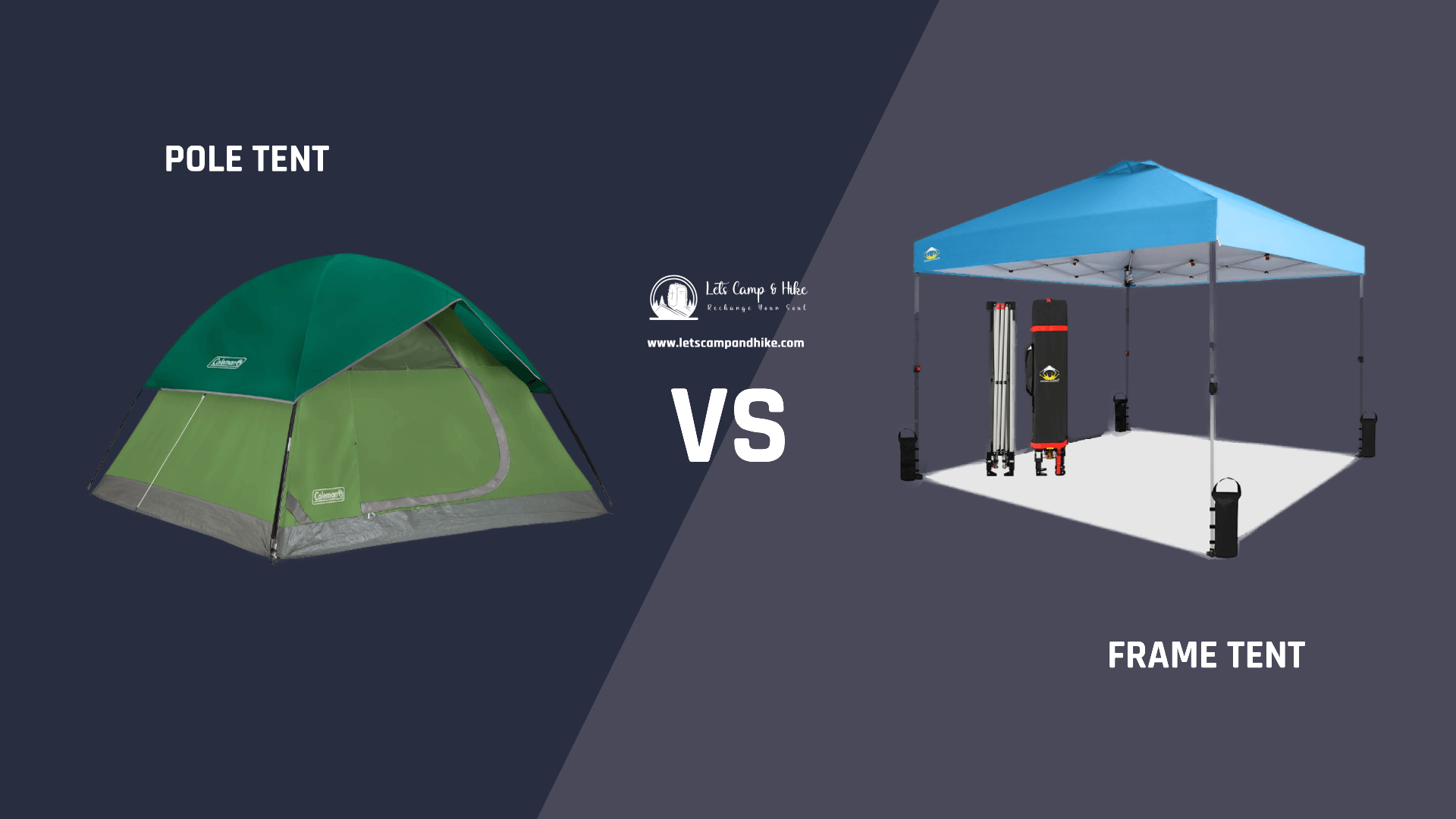Camping can be one of the most exhilarating experiences, but ensuring you have the right gear makes all the difference between a pleasant trip and a struggle against nature’s elements. One crucial but often overlooked component is ground protection for your tent. The debate between tent footprints vs tarps is a common one among campers. Which one should you choose? Let’s break down the differences between a tent footprint and a tarp so you can make an informed decision.
- Also read:
Tent Footprint vs Tarp: Comparison Table

Here’s a comparison table of the Tent Footprint vs Tarp, allowing you to quickly assess the best option for your tent’s protection based on various criteria such as cost, ease of setup, versatility, weather resistance, comfort, and durability.
Feature | Tent Footprint | Tarp |
Preview | ||
Primary Function | Protects the tent floor from abrasion and moisture. | Versatile – used as ground cover, shelter, or rainfly. |
Material | Typically made from polyester or nylon with waterproof coatings. | Made from polyethylene, canvas, or nylon. Some are reinforced with ripstop. |
Fit | Custom-sized to match specific tent dimensions. | Comes in various sizes, requires folding and adjustment to fit under a tent. |
Durability | Durable and designed to last when used with the right tent. | Highly durable, but wear depends on multi-purpose usage. |
Weight | Lightweight (5–15 ounces), designed for backpacking. | Varies widely (1–5+ pounds), generally bulkier than footprints. |
Portability | Compact and easy to pack with the tent. | Bulkier, takes up more space in the pack, especially larger sizes. |
Setup Ease | Easy and quick to set up, custom-made for the tent. | Requires more adjustment, folding, and securing with stakes or anchors. |
Versatility | Single-purpose, designed only as a tent groundsheet. | Multi-functional – can be used as a groundsheet, shelter, or rain cover. |
Weather Protection | Provides targeted protection for the tent base. | Offers broader weather protection as rainfly or shelter. |
Longevity | Can last many years with proper care. | Durable but might wear faster with multi-use purposes. |
Use in Different Setups | Only compatible with matching tent models. | Works with various tent sizes and setups, but may require adjustments. |
Best For | Precise tent floor protection and ultralight camping. | Campers needing versatile gear for different scenarios. |
Budget-Friendliness | Higher cost for a specialized, single-purpose item. | More budget-friendly for multi-use outdoor needs. |
Price |
What Is a Tent Footprint?
A tent footprint is a custom-sized piece of fabric designed to fit directly under your tent, providing an extra layer of protection. Tent manufacturers often sell these to pair specifically with specific tent models.
Materials Used in Tent Footprints
Tent footprints are typically made from durable, waterproof materials like polyester or nylon. These fabrics are treated with a waterproof coating, such as polyurethane (PU), to protect against moisture and abrasion from the ground.
Common Sizes and Shapes
Footprints are designed to match the shape and size of your tent. They come in various shapes—rectangular, square, or custom-cut—to cover the exact dimensions of the tent’s base, ensuring full coverage and optimal protection.
- Material: Polyester
- Item Weight: 0.28 Kilograms
- Water Resistance: Waterproof
What Is a Tarp?
A tarp is a large, multi-purpose sheet of durable material, often made from polyethylene, canvas, or nylon. It’s widely used in camping for a variety of purposes, such as ground cover, shelter, or even as an extra rain cover.
Materials Used in Tarps
Most tarps are made from polyethylene or vinyl, which are water-resistant and highly durable. Some lightweight versions use nylon, especially for backpackers. Tarps can also be reinforced with ripstop technology, making them resistant to tears and punctures.
Versatility of Tarps
Unlike tent footprints, tarps are highly versatile. You can use them not only as ground protection but also as rain covers, makeshift shelters, or even as windbreaks. This adaptability makes tarps an attractive option for campers looking for multi-functional gear.
- Material: Polyethylene (PE)
- Item Thickness: 120 Inches
- Water Resistance: Waterproof
Tent Footprints Vs Tarp: Key Differences
While both tent footprints and tarps protect your tent from the elements, they differ significantly in function, durability, weight, cost, and versatility.
Purpose and Functionality
Primary Function of a Tent Footprint
The main purpose of a tent footprint is to protect the tent floor from abrasion, dirt, and moisture. Matching the tent’s base dimensions ensures full protection without any exposed areas where water could pool or seep into the tent.
Primary Function of a Tarp
A tarp’s primary function is to serve as a versatile piece of gear for various camping needs. When used as a groundsheet, it shields your tent from sharp rocks, mud, and moisture. However, tarps can also serve other roles, like providing extra shelter or covering gear.
Situational Uses for Both
A tent footprint is ideal for campers looking for seamless protection tailored to their tent. At the same time, a tarp is better for those who want flexible options—be it ground cover, rainfly, or shelter. If you expect unpredictable weather or challenging terrain, a tarp may offer more versatility.
Durability and Protection
How a Tent Footprint Protects Your Tent
Tent footprints are made from durable fabrics that are designed specifically for wear and tear. They create a barrier between your tent and the ground, protecting the tent floor from punctures and wear over time while also minimizing moisture penetration.
How a Tarp Protects the Ground and Tent
A tarp serves as a strong barrier between the ground and your tent, providing a waterproof surface that can prevent moisture from soaking through. While it may not be as tailored as a footprint, it still offers robust protection from sharp objects and harsh conditions.
Longevity and Weather Resistance
Tent footprints tend to last longer when paired with their intended tent, as they are less likely to be exposed to extreme tension or overuse. Tarps, on the other hand, are designed to be multi-purpose, meaning they may wear down faster depending on their use and material strength.
Weight and Portability
Tent Footprint Weight Considerations
Most tent footprints are lightweight and compact, as they are designed to pair with lightweight backpacking tents. The weight typically ranges from 5 to 15 ounces, depending on the size and material.
Tarp Weight Variations and Packability
Tarps vary in weight depending on the material and size. Lightweight tarps for backpacking can weigh as little as 1 pound, while heavier-duty tarps used for larger setups may weigh several pounds. Generally, tarps offer less packability than footprints due to their bulk.
Which Is Lighter for Backpacking?
For ultralight backpackers, tent footprints tend to be the lighter option, as they are purposefully designed to match the tent without adding unnecessary weight. Tarps, although more versatile, are often bulkier and heavier, especially when larger sizes are required.
Tent Footprint Vs Tarp: Cost Comparison
Average Price of Tent Footprints
The price of a tent footprint typically ranges from $30 to $60, depending on the tent brand and size. High-end models can cost even more, especially if they are custom-fit for premium tents.
Price Ranges for Tarps
Tarps are generally more affordable than tent footprints, with prices ranging from $10 for small, essential tarps to $50 or more for more extensive, reinforced models. Tarps offer better value in terms of cost per square foot.
Budget Considerations
If budget is your main concern, tarps provide a more cost-effective option, especially for campers looking for a multi-purpose solution. However, tent footprints are worth the investment if you want protection tailored specifically for your tent.
- Material: Polyester
- Item Weight: 0.28 Kilograms
- Water Resistance: Waterproof
Ease of Setup
Setting Up a Tent Footprint
Setting up a tent footprint is quick and easy. Since it’s designed to fit your tent, all you need to do is lay it out underneath the tent and align the corners. Most modern tents come with attachment points to secure the footprint in place.
Setting Up a Tarp as a Tent Groundsheet
Setting up a tarp requires more effort. You’ll need to measure and fold it to fit under your tent, and then secure it with stakes or other anchors. If not properly secured, tarps can shift during the night, reducing their effectiveness.
Comparison of Effort and Time
A tent footprint offers a quicker, hassle-free setup compared to a tarp, which requires more adjustment and securing. For campers who value simplicity and speed, footprints have the edge.
- Material: Polyester
- Item Weight: 0.28 Kilograms
- Water Resistance: Waterproof
Versatility and Multiple Uses
Single-Purpose of a Tent Footprint
Tent footprints serve one primary function: to protect your tent floor. While they do their job well, they aren’t designed for any other purposes, making them less versatile than tarps.
Multi-Functional Nature of Tarps
Tarps, on the other hand, are incredibly versatile. You can use them as ground covers, rainflies, makeshift shelters, gear covers, or even picnic blankets. Their multi-functionality makes them an excellent tool for campers seeking flexibility.
Alternative Uses for Tarps Beyond Camping
Beyond camping, tarps can be used for a variety of purposes—covering firewood, protecting equipment, or even as an emergency shelter. This makes them a valuable asset for outdoor enthusiasts, gardeners, and homeowners alike.
- Material: Polyethylene (PE)
- Item Thickness: 120 Inches
- Water Resistance: Waterproof
Tent Footprint Vs Tarp: Pros and Cons
Tent Footprint
Advantages:
- Custom Fit for Tents: Footprints are made to match your tent perfectly, ensuring maximum protection.
- Enhanced Protection for Tent Floors: They prevent wear and tear, especially in rough terrains.
- Lightweight and Compact for Specific Models: Footprints are generally lighter and easier to pack than tarps, particularly for backpackers.
Disadvantages:
- Limited Versatility: They can only be used with their matching tent.
- Higher Cost for Branded Options: Footprints are often more expensive than tarps, especially for high-end brands.
- Only Useful with Matching Tent Models: If you switch tents, you’ll need a new footprint.
Tarp
Advantages:
- High Versatility: Tarps have many uses beyond just being a ground cover.
- Affordable and Widely Available: They are easy to find and usually cost less than tent footprints.
- Can Be Used for Various Camping Setups: From ground covers to rainflies, tarps are adaptable to your camping needs.
Disadvantages:
- May Not Fit Perfectly with All Tent Models: You’ll need to adjust and fold tarps to match your tent size.
- Heavier and Bulkier than Footprints: Larger tarps can add bulk to your pack.
- Requires More Setup and Adjustment: Setting up a tarp can take longer and may involve extra securing.
Tent Footprint Vs Tarp: How to Choose?
Camping Environment Considerations
Your choice depends mainly on the terrain and weather. For rocky, muddy, or damp environments, a footprint may provide better protection for your tent. Tarps, however, excel in unpredictable weather or for creating extra shelter.
Tent Compatibility and Size Factors
If you have a specific tent model, a footprint designed for that tent will offer the best fit. Tarps, though more flexible, require more work to fit different tent sizes and shapes.
Budget and Value Considerations
For budget-conscious campers, tarps offer more value. However, if you camp frequently and want a reliable solution, investing in a footprint may be more cost-effective over time.
When to Use a Tent Footprint Over a Tarp
A tent footprint is ideal in situations where you need precision, such as camping on rocky or abrasive ground. It’s also helpful if you want a lightweight, easy-to-use option tailored to your tent’s dimensions.
- Material: Polyester
- Item Weight: 0.28 Kilograms
- Water Resistance: Waterproof
When to Use a Tarp Over a Tent Footprint
Tarps are better when versatility is key. Suppose you’re dealing with unpredictable weather or need multiple uses for one piece of gear. In that case, a tarp will provide more flexibility and value.
- Material: Polyethylene (PE)
- Item Thickness: 120 Inches
- Water Resistance: Waterproof
Tips for Proper Usage of Tent Footprints and Tarps
Correct Placement and Setup
- Tent Footprint: Ensure the footprint is fully aligned with your tent to prevent water pooling underneath.
- Tarp: When using a tarp, make sure it’s fully secured with stakes and that excess material is folded under the tent to avoid water catching.
Maintenance and Care for Both
- Footprint: After use, shake off dirt and dry it before storage to prevent mildew.
- Tarp: Clean and fold your Tarp carefully after use, ensuring it’s stored in a dry place to avoid wear.
Tent Footprint Vs Tarp: Which Is Better?
In conclusion, both tent footprints and tarps offer distinct benefits. If you’re looking for something lightweight, easy to set up, and designed to protect your tent floor, a footprint is the way to go. However, if you prefer versatility and a multi-purpose piece of gear, a tarp is the better option. Your choice depends on your camping needs, environment, and budget.
Keep up with Let’s Camp & Hike to learn more about camping and hiking tips and tricks.
- Material: Polyester
- Item Weight: 0.28 Kilograms
- Water Resistance: Waterproof
- Material: Polyethylene (PE)
- Item Thickness: 120 Inches
- Water Resistance: Waterproof
Why Trust The Let’s Camp & Hike?
In every review, the Let’s Camp & Hike team conducts thorough research and spends hours reviewing the top models before recommending products.
Among other requirements, a product must have a strong track record of sales on Amazon, primarily favorable customer feedback, and special features to join our list of the best options.
Once we have whittled down our list of suggestions, we conduct more investigations and perhaps in-person testing to ensure the goods live up to our expectations. After the research phase, we create a comprehensive, easy-to-read article with our top picks and extra details to assist outdoor enthusiasts like you in making the best choice.
FAQS
Do I really need a tent footprint or a tarp?
While not essential, using a footprint or Tarp can significantly extend the life of your tent by protecting it from wear, tear, and moisture.
Can I use a regular tarp as a tent footprint?
Yes, you can use a tarp as a tent footprint, though you may need to adjust and fold it to fit under your tent correctly.
How long do tent footprints last compared to tarps?
Tent footprints can last for years if used and maintained correctly, while tarps may wear out faster if used for multiple purposes.
What are the best materials for tarps and tent footprints?
Polyester and nylon are the most common materials for tent footprints. At the same time, polyethylene and canvas are popular for tarps due to their durability and water resistance.
Is it better to have both a tent footprint and a tarp?
In some cases, having both can be useful. You can use the footprint under your tent and the Tarp for extra coverage or shelter in harsh weather conditions.




























